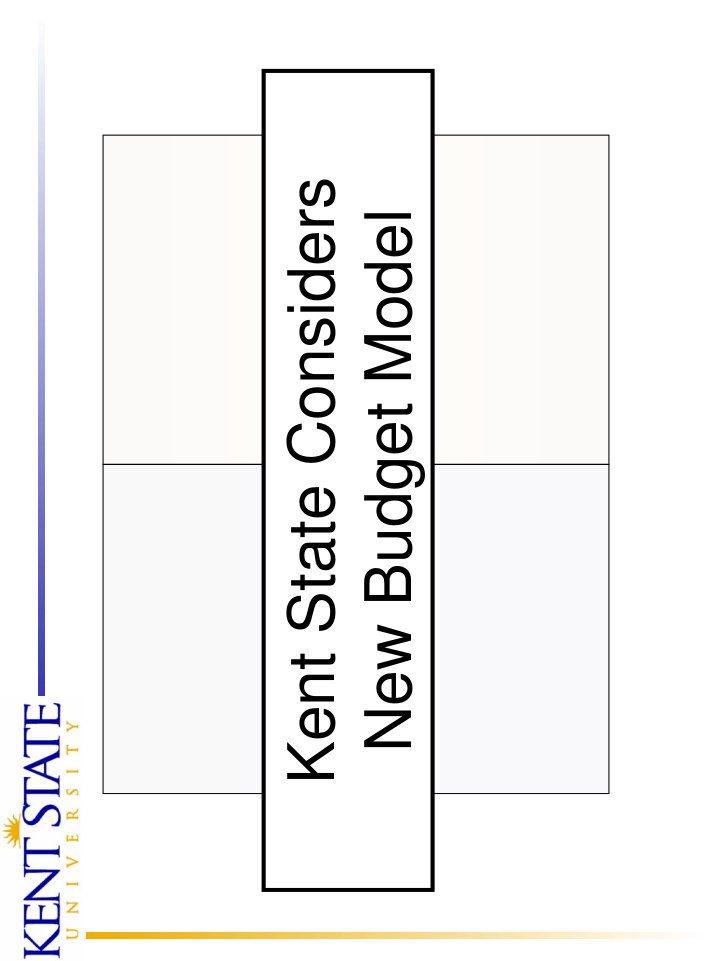



Kent State Considers New Budget Model
Guiding Questions • Are there budget approaches that would be better suited to Kent State than the current model? • Is RCM an appropriate budget approach to respond to today’s academic and financial challenges? • If it is determined that RCM is the most feasible approach, how should it be implemented? April 18, 2007 2
Need for Change Changes in Source of Revenue Kent Campus 1980 2006 11.7% 6.7% 27.9% 31.3% 62.0% 60.4% State Appropriation Tuition and Fees Other State Appropriation Tuition and Fees Other April 18, 2007 3
Need for Change Kent Campus – Fall Enrollments Actual for Fall 2002 to Fall 2006 and Projected for Fall 2007-2010 25,000 24,347 24,242 24,000 23,622 23,504 23,000 22,697 22,016 22,000 21,576 21,144 21,000 20,721 20,000 19,000 18,000 Fall Fall Fall Fall Fall Fall Fall Fall Fall 2002 2003 2004 2005 2006 2007 2008 2009 2010 April 18, 2007 4
Need for Change Trends in Funding for Doctoral Programs (Values in Millions) $18 $16.1 $15.8 $15.8 $16 $14 $13.5 $13.2 $13.2 $13.1 $13.0 $12.8 $12 $10 FY FY FY FY FY FY FY FY FY 1999 2000 2001 2002 2003 2004 2005 2006 2007 April 18, 2007 5
Need for Change • Besides the funding changes, the University requires a budget process that more closely aligns with shared governance and is more transparent. April 18, 2007 6
What is RCM? • RCM is a very flexible budget approach. • Academic colleges become responsibility centers with budgets similar to regional campuses and auxiliary operations today. • Revenues and expenses are assigned to the responsibility centers. April 18, 2007 7
What is RCM? (continued) • Methods are developed for allocating revenues and expenses to responsibility centers. • A central budget pool (subvention) usually exists to help fund academic programs that are a priority but not financially independent. • Information and data are used more extensively in making decisions. April 18, 2007 8
Potential Concerns Potential Benefits • Too much focus on • Integrated academic and financial performance budget planning only • Colleges and campuses • Activities can become have greater control of insular financial resources • Inappropriate internal • Transparent decision- competition can weaken the whole making • Improved university outcomes April 18, 2007 9
Changes that Would Accompany RCM • Greater need for planning by academic colleges. • More control of financial resource decisions by academic colleges. • Increased need for information to support planning and decision-making. • More consideration of financial impact resulting from academic program decisions. April 18, 2007 10
Changes that Would Accompany RCM (continued) • New knowledge and skills may be required by some academic leaders. • Greater expectations about cost and service levels for central administrative services. • More distribution of financial accountability for university outcomes. April 18, 2007 11
12 my college or campus? How will RCM affect April 18, 2007
Summary • RCM is intended to produce improved university outcomes � Reduce barriers to generating new revenues � Better align financial resources with today’s academic needs � Improve outcomes for students � Decentralize budget decisions � Increase transparency in the budget process � Improve the understanding of university finances by faculty and staff • University community must consider the changes that would accompany the use of RCM. • Strong leadership and effective decision-making, at all levels, are imperative for success. April 18, 2007 13
What does the committee need from you? Discussion
Recommend
More recommend